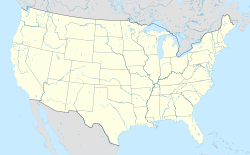Top Qs
Timeline
Chat
Perspective
Armstrong Tunnel
United States historic place From Wikipedia, the free encyclopedia
Remove ads
The Armstrong Tunnel in Pittsburgh, Pennsylvania, connects Second Avenue at the South Tenth Street Bridge, under the Bluff where Duquesne University is located, to Forbes Avenue between Boyd Street and Chatham Square.
Remove ads
Construction
The tunnel was constructed between 1926 and 1927. The chief engineer was Vernon R. Covell of the Allegheny County Public Works Department. The tunnel portals were designed by a city architect, Stanley L. Roush, who is also noted for the Smithfield Street Bridge portals, the Pittsburgh City-County Building, the Corliss Tunnel, and many other municipal projects.[citation needed]
Characteristics
The tunnel itself is characterized by twin bores of horseshoe cross-section, and bends halfway through. It also has a pedestrian walkway on the western side.[citation needed]
A legend mentioned by the site involves a notion that the bend in the tunnel was a mistake, and whoever was responsible committed suicide in shame. Chief engineer Covell did not kill himself, invalidating this legend. Author Bruce S. Cridlebaugh suspects the bend was related to mines or other geological factors, property rights (including Duquesne University), or alignments with existing or proposed roads.[citation needed]
Since August 1987 the tunnels have provided cellular phone reception.[3]
Remove ads
Name
The tunnels were named in honor of Joseph G. Armstrong, County Director of Public Works. Most of the bridges over the Pittsburgh's three rivers were replaced between 1910 and 1940, years which included Mr. Armstrong's terms as Mayor of Pittsburgh and Allegheny County Commissioner.[citation needed]
References
External links
Wikiwand - on
Seamless Wikipedia browsing. On steroids.
Remove ads




